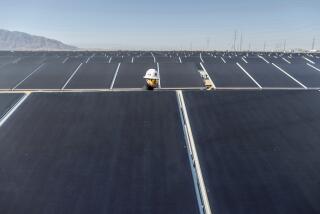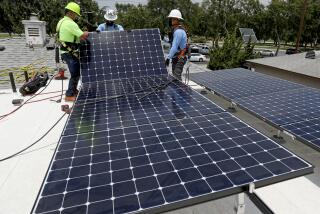Opinion: A wind farm off Massachusetts should be just the start

The Biden administration on Tuesday granted permission for what is described as the first utility-scale offshore wind farm near Martha’s Vineyard and Nantucket, the first step in delivering on its promise to goose development of wind energy — a significant part of ending our reliance on fossil fuels.
President Biden said in March that he wanted to build enough offshore wind-power capacity by the end of the decade to create 30 gigawatts of power — enough to power 10 million homes. The proposed Vineyard Wind project would produce 800 megawatts beginning in late 2023, enough to power 400,000 homes and businesses.
Six people were killed in another Colorado mass shooting over the weekend. Such gun violence is, sadly, normal here in the land of the free.
Which makes this approval a relatively small but crucial step forward. The truth is, the U.S. needs much more wind power, and solar power, if we are to end our reliance on fossil fuels for energy. And that will mean wind farms off the California coast, too, and soon.
As it is, about 60% of our current utility scale production comes from fossil fuel; about 20% comes from renewable sources, including 8.4% from wind, according to the U.S. Energy Information Administration.
That needs to shift — radically.
The clock is ticking. Loudly. Experts warn that we need to reach net-zero carbon emissions by 2050 — in fewer than 30 years — if we are to avoid the worst effects of climate change driven by global warming.
Sanctioned campgrounds to shelter homeless people are fine as a temporary measure only.
We’re already seeing the effects of climate change in more intense wildfires in the West, extended droughts, more powerful and faster developing hurricanes along the Atlantic and Gulf coasts, and potentially radical shifts in biodiversity.
As The Times editorial board noted in March:
“The vast majority of Californians recognize the threat of global warming — tens of thousands of people have already suffered the effects of staggeringly powerful wildfires feeding on dried-out terrain. We all must do more, faster to counter the effects of lifetimes of fossil fuel consumption. This will be expensive, and not all the steps will be popular, but we must proceed with haste along the clearest paths we are presented. And offshore wind power generation, done in ways that mitigate the environmental impact, is one of them.”
More to Read
A cure for the common opinion
Get thought-provoking perspectives with our weekly newsletter.
You may occasionally receive promotional content from the Los Angeles Times.









